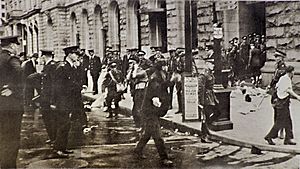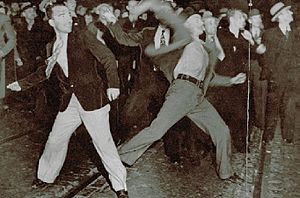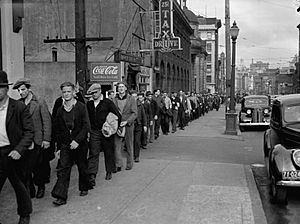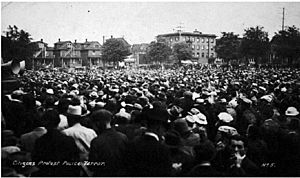Bloody Sunday (1938) facts for kids
Quick facts for kids Bloody Sunday |
|||
|---|---|---|---|
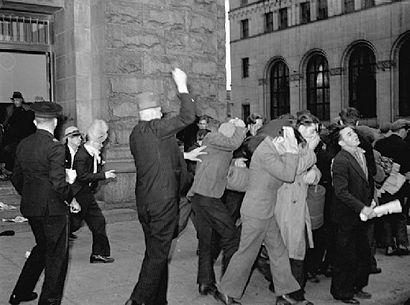
A plainclothes Mountie clubbing protesters leaving the post office
|
|||
| Date | 19 June 1938 | ||
| Location |
Vancouver, British Columbia, Canada
|
||
| Caused by |
|
||
| Resulted in | No concessions given | ||
| Parties to the civil conflict | |||
|
|||
| Lead figures | |||
|
|||
| Casualties | |||
| Injuries | 100 injured (43 hospitalized) | ||
Bloody Sunday was a big event that happened on June 19, 1938, in Vancouver, British Columbia. It was the end of a month-long protest by unemployed men. They were doing a 'sit-down strike' at the main post office. This event was one of the last big clashes between jobless protesters and the police during the Great Depression. Many people were upset about how the police handled it.
What Led to Bloody Sunday?
During the Great Depression, many people in Canada did not have jobs. The government set up "relief camps" to help these unemployed men. In these camps, men worked for very little money.
After a big protest in 1935, these camps were changed to "relief projects." These projects were run by the provinces and paid a bit more. Many unemployed men went to British Columbia because the weather was milder. Also, the forestry projects there paid more than farm jobs.
In early 1938, the federal government stopped giving money to the provinces for these projects. So, British Columbia closed its projects. This left many men without work or support again.
These men came to Vancouver to protest. The Relief Project Workers' Union (RCPU) helped organize them. A young leader named Steve Brodie, who was part of the Communist Party of Canada, led the protests. Protesters took over important buildings like the Hotel Georgia, the Vancouver Art Gallery, and the main post office.
The Protest Begins
On May 20, 1938, about 1200 men marched from different parts of Vancouver. Many thought they were going to a rally in Stanley Park. But some groups went to the post office instead. More than 700 men occupied the post office building.
Other groups went to the Hotel Georgia and the art gallery. The owner of Hotel Georgia did not want police to remove the men. He was worried about damage to his property. Instead, he paid the men $500 to leave.
The protesters at the art gallery and post office stayed for weeks. The art gallery closed during this time. The RCPU wanted its members to be disciplined. This was to gain public support, not lose it.
The police chief, Colonel W. W. Foster, tried to get the men to leave. He said they had made their point. But Steve Brodie said they had nowhere to go. The protesters offered to be arrested peacefully. The chief did not want to arrest so many men. He thought they would leave on their own.
However, the protest continued for weeks. The police waited for orders to remove the men. Chief Foster had a reputation for being fair with protesters. But secretly, he was planning with politicians and the Royal Canadian Mounted Police (RCMP) to clear the buildings.
The Eviction
Early on June 19, 1938, police moved in to remove the protesters. They chose this time to surprise the men and avoid many onlookers.
At the art gallery, a person named Harold Edward Winch helped. He had worked with police and protesters before. He helped make sure the art was safe. Police used tear gas, and the men left peacefully.
The post office was different. It was a federal building, so the RCMP led the action. Steve Brodie, the leader there, was known for being very determined. When the RCMP used tear gas, the men broke windows for air. They also grabbed things to throw.
The RCMP went into the building and forced the men out. As the men left, police hit them with batons. City police outside also helped. Many people were injured. Out of 42 people who went to the hospital, only five were police officers.
What Happened Next?
After being forced out, the protesters and their supporters marched back to the East End. On the way, they broke windows at department stores and other places. This caused about $35,000 in damage.
The Ukrainian Labour Temple became a temporary hospital. Volunteer doctors helped the injured protesters.
News of the event spread quickly. That afternoon, which was Father's Day, between 10,000 and 15,000 people gathered at the Powell Street Grounds. They were protesting against the police actions on Bloody Sunday. Many thousands also went to the CPR pier. They wanted to see off a group going to meet the premier in Victoria.
The premier, Thomas Dufferin Pattullo, refused to help the unemployed. He said they had already received "too much sympathy." He used the incident to argue that the federal government needed to give money back to the provinces for relief. However, Prime Minister William Lyon Mackenzie King said that helping the unemployed was the provinces' job.


